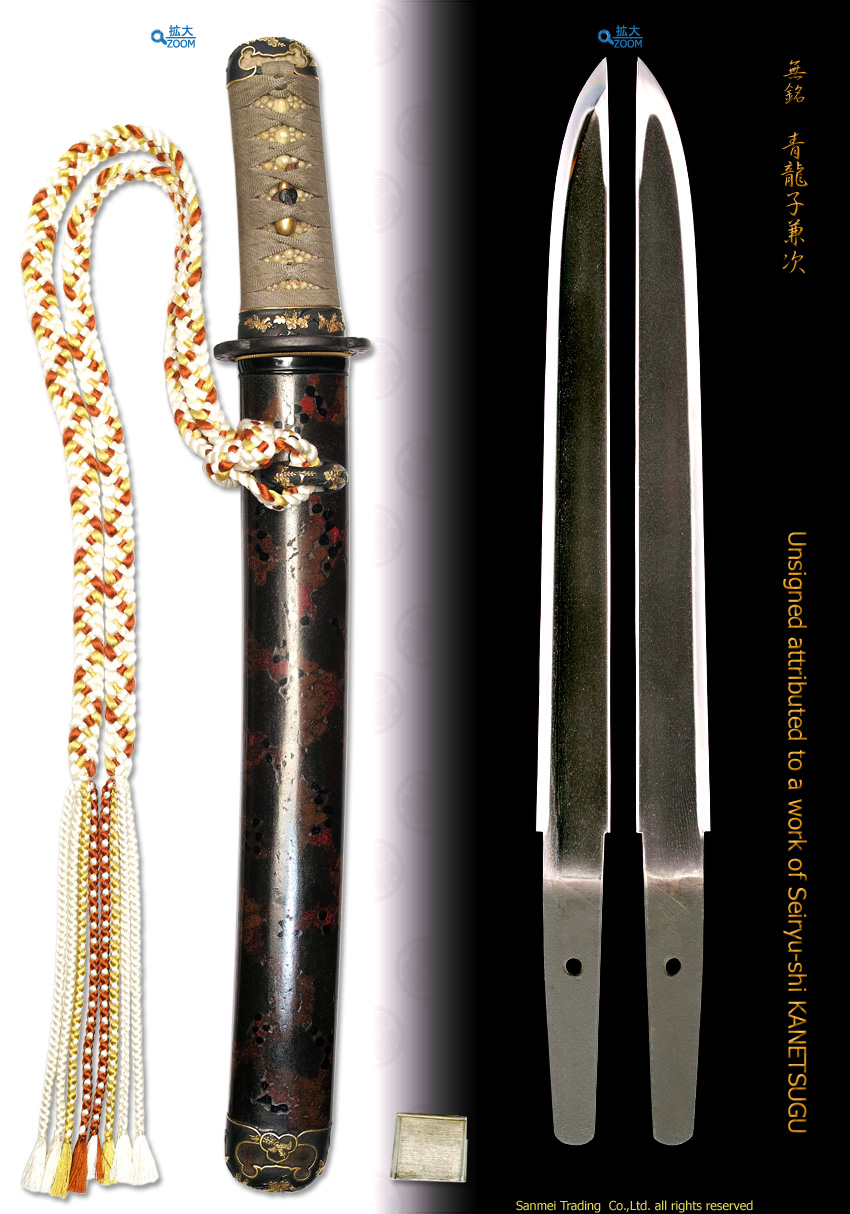with) Kiri Phoenix design Tanto Koshiare
Length of cutting edge 25.9cm A bit on inward curve Width of base 24.5mm Thickness of base 7.2mm
Forging(Hada): Forging mark is minute Masame-hada gentle stream grain where is thickly covered with sparkling martensite glitter so called Ji-Nie consequently darkish Nie lines of streaming Masame so called Chikei activity gushes out from steel.
Hamon : Hamon is Suguha mixing with a few indication of Hotsure flay. There is rich Nie activity of which interior is covered in deep Nioi-mist and temper edge is thickly accumulated with sparkling Nie which is vividly bright. The interior of temper is filled with misty Nioi that works with delicate lines of Sunagashi activity.
Temper of tip(Boshi) : Boshi blushes up so called Hakikake of which tip indicates Sukagashi - sweep up Nie activity, small circle turns back.
Tang(Nakago) : Nakago is UBU in original. One peg hole. File mark is Ō-Sujikai greatly slanting left with horizontal Kesho.Kurijiri (double bevelled) heel shape in full on bottom. Back ridge of Nakago is round contour in full.
Rikuzen province, (now in Miyagi pref.) founder KANETSUGU 兼次 who belonged to YASUTOMO 安倫 school, later learned from Izumi-no-kami KANESHIGE 和泉守兼重, was excellent in conspicuous forging technique such as Ayasugi, Matsukawa or Masame and the next 2 nd generation KANETSUGU 兼次 learned from 4 th generation KUNIKANE 国包 to acuire pure Masame technique from Yamato Houshō tradition since Kamakura period. An unusual forging technique had been handed down to the 5 th generation until end of Edo period.
The subject unique style of Kiri-ha-zukuri tanto and the original incidental Koshirae mounting were made intentionally unsigned as an article which might suppose to be presented to his lord or master but not made for market sales. From those unique features of this tanto, it is recently judged as a work of 5 th generation KANETSUGU 兼次 with the a title of Seiryu-shi 青龍子 in Rikuzen domain (now in Sendai city, Miyagi pref.) by NBHTK (Japanese Sword Preservation Society). The matchless forging ware of minute Masame-hada expresses close resemblance to the ancient work of Houshō from Kamakura period.
Kiri Paulownia blossom Phoenix design Tanto Koshiare of superfine quality consists of :
(click HERE for entire Koshirae and HERE for each firring)
- All metal fittings (Fuchi/kashira, Kurikata and Kojiri) of Kiri/Phoenix design made of Shakudo ground Nanako-ji surface, Gold Iroe/gold Koberi rim, unsigned
- Tsuba Kiri/waves design, Iron ground cross rectangular shape, Sukisage carving, gold inlay, unsigned attributed to a work of NORISUKE 則亮
- Kozuka Yodobashi bridge, water wheel design, Silver ground Takabori carving, Shakudo, gold and copper Yamagane Iroe, unsigned a work of Kaga
- Menuki Gourd design, Yobori carving, Gold, Shakudo alloy and copper Iroe
- Tsuka White rayskin, yellowish green silk cord lozenge warp
Recent polish/Condition scale: mint-excellent (using a scale of mint-excellent-very good-good-fair-poor).
reference data : Sendai-han Tosho meifu, NBHTK (Japanese Sword Preservation Society) Miyagi branch, 1973



